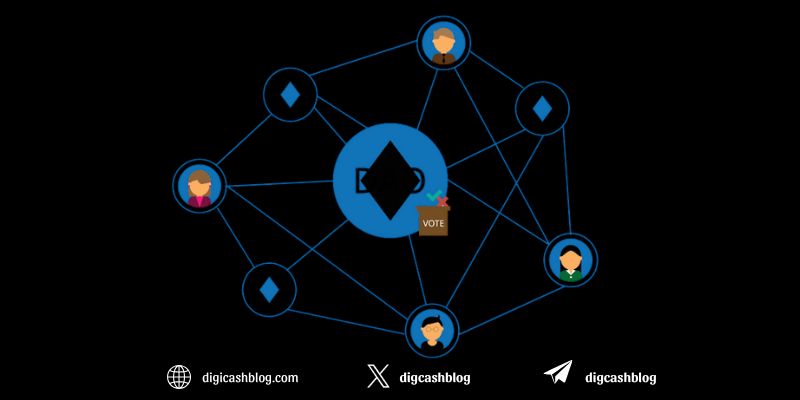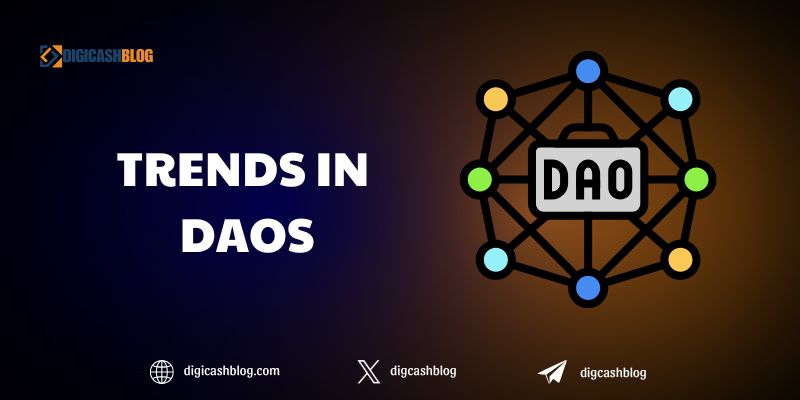Introduction to DAOs in 2025
Decentralized Autonomous Organizations (DAOs) have emerged as a transformative force in the blockchain ecosystem, redefining governance, collaboration, and resource allocation. Operating on smart contracts and powered by blockchain technology, DAOs enable community-driven decision-making without centralized authority. As of 2025, DAOs manage approximately $21.4 billion in liquid assets across over 10,000 active organizations globally, reflecting a 30% annual growth rate. This article explores the trends in decentralized autonomous organizations (DAOs) for 2025, highlighting their evolving role across industries, technological advancements, and challenges shaping their future.
Institutional and Corporate Adoption of DAOs
A significant trend in 2025 is the growing adoption of DAOs by corporations and institutions. Major companies like L’Oréal’s NYX and governments in regions like Japan are experimenting with DAO frameworks to streamline operations and enhance transparency. Investment DAOs, such as MetaCartel Ventures, have raised over $1 billion by pooling resources for venture capital, democratizing investment opportunities. This trend is driven by the promise of reduced transaction costs and disintermediation, allowing organizations to bypass traditional hierarchies. For instance, DAOs like Uniswap govern DeFi protocols, enabling token holders to vote on upgrades and fee structures, fostering trust and scalability.

Real-World Asset (RWA) Tokenization and DAOs
RWA tokenization is a major driver of DAO growth in 2025, with the market for tokenized assets reaching nearly $20 billion in Q1 and projected to surpass $50 billion by year-end. DAOs are increasingly used to tokenize assets like real estate, gold, and intellectual property, enhancing liquidity and fractional ownership. For example, Farmchain Finance DAO facilitates tokenized real estate investments, empowering communities through collaborative funding. This trend aligns with broader blockchain adoption, as financial institutions like BlackRock embrace tokenization for its efficiency and global accessibility, making DAOs a key vehicle for managing these assets.
AI Integration in DAO Governance
The convergence of artificial intelligence (AI) and DAOs is a transformative trend in 2025. AI-powered tools are being integrated to optimize governance processes, analyze voting data, and provide data-driven recommendations. For instance, Kava AI is streamlining DAO proposals and coordination, enhancing efficiency at scale. AI also supports decentralized identity solutions, improving member verification and privacy protection. This trend addresses voter fatigue and low participation, issues highlighted in recent discussions on X, where users note that DAOs risk disillusionment without streamlined governance. By automating complex decision-making, AI-driven DAOs are poised to enhance scalability and engagement.
Cross-Chain and Layer 2 Solutions
Cross-chain interoperability and Layer 2 solutions are reshaping DAO operations in 2025. With the rise of multi-chain ecosystems, DAOs are adopting cross-chain governance to operate across blockchains like Ethereum, Polygon, and Binance Smart Chain, which saw 40% treasury growth year-over-year. Layer 2 solutions, such as Optimism and Arbitrum, enable faster and cheaper transactions, addressing scalability issues. For example, Grape Network DAO leverages these tools to enhance community management efficiency. This trend supports seamless collaboration across platforms, expanding DAOs’ influence and operational capacity.
Evolving Regulatory Frameworks
Regulatory clarity is a critical trend influencing DAOs in 2025. Governments are developing frameworks to define DAOs’ legal status, with Utah’s Decentralized Autonomous Organizations Act treating DAOs as equivalent to limited liability companies. The EU’s MiCA regulation, while increasing compliance costs, provides a structured environment for DAO operations. However, regulatory fragmentation remains a challenge, as noted in posts on X, where users discuss how centralized control in some DAOs undermines decentralization. Clearer policies are expected to boost investor confidence and mainstream adoption, particularly for DAOs managing significant treasuries, such as Uniswap’s $2 billion treasury.

SubDAOs and Specialized Governance
The rise of SubDAOs—smaller, autonomous groups within larger DAOs—is a notable trend in 2025. SubDAOs, like Balancer Emergency SubDAO, enable faster decision-making for specific tasks, such as risk management, without requiring majority votes from the parent DAO. This structure enhances efficiency and scalability, addressing concerns about slow decision-making in large DAOs. For example, Kula DAO’s DoubleDAO model separates capital management (KulaDAO) from regional operations (RegionalDAOs), offering a blueprint for scalable governance. This trend is gaining traction as DAOs mature into complex ecosystems.
Challenges Facing DAOs in 2025
Despite their growth, DAOs face significant challenges:
- Voting Power Concentration: Posts on X highlight that many DAOs are oligarchic, with less than 1% of token holders controlling 90% of voting power, undermining decentralization.
- Security Risks: Smart contract vulnerabilities remain a concern, with 2022 seeing $3 billion in losses from crypto heists. Robust security measures are critical to protect DAO treasuries.
- Low Voter Engagement: Slow decision-making and voter fatigue, as noted in X discussions, hinder efficiency, necessitating streamlined voting mechanisms.
- Regulatory Uncertainty: While progress is being made, fragmented global regulations complicate DAO adoption, particularly for cross-border operations.
Practical Tips for Engaging with DAOs in 2025
- Participate Actively: Buy governance tokens or contribute skills to influence DAO decisions, as seen with platforms like MakerDAO.
- Leverage AI Tools: Use AI-driven platforms for market analysis and proposal optimization to stay competitive in DAO governance.
- Monitor Regulatory Changes: Stay updated on laws like Utah’s DAO Act to ensure compliance and mitigate risks.
- Diversify Involvement: Engage with DAOs across sectors (DeFi, gaming, RWAs) to spread risk and capitalize on diverse opportunities.
- Use Technical Analysis: Apply tools like Moving Averages to assess token price trends, aiding investment decisions in DAOs like Uniswap or Aave.
The trends in decentralized autonomous organizations (DAOs) for 2025 reflect their growing influence across finance, gaming, content creation, and asset tokenization. With $21.4 billion in treasuries and innovations like AI integration, cross-chain governance, and SubDAOs, DAOs are reshaping organizational structures. However, challenges like voting power imbalances, security risks, and regulatory hurdles must be addressed to sustain growth.
